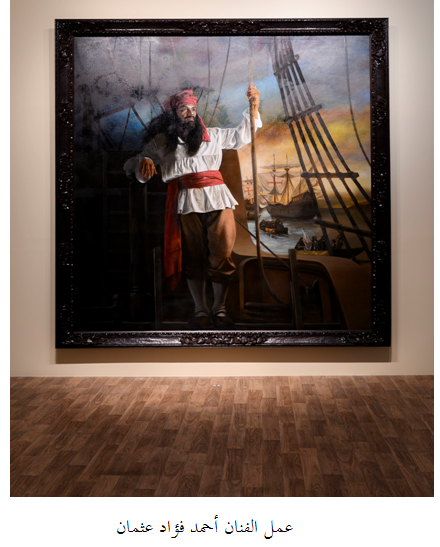Learn about the works of the artists participating in the 14th Sharjah Art Biennale
In the heart of Sharjah, the Calligraphy Center hosts a series of projects and works of art that were evaluated by the artist Zwa Bitt under the theme "A Journey Beyond the Path" within the Sharjah Biennale 14. The works are presented at Sharjah Calligraphy Museum, Calligrapher Houses, Sharjah Calligraphy Center, , And the Emirates Association of Arabic Calligraphy and Decoration.
"A journey beyond the path" in the social, economic, political and ideological contexts that hampered the movement, causes and effects of humanity, and how the collective sense of humanity has been suppressed by rigid bureaucratic systems, artists reveal the intergenerational effect of a range of physical and psychological tools, The need for exchange and diversity around the world.
"Dragon King on the Rock of Pride" is the work of Anawana Haluba, who explores the presence of China in Africa and its impact on the lives of the general population in Zambia. In particular, China contributed to the establishment of the Tazara Railroad to form a united front to protect Africa's sovereignty.
The project, which was completed between 1968 and 1975, is China's first and largest infrastructure project in Africa, and Zambia has no sea port. The Tazara railway is seen as a step towards anti-apartheid, a symbol of freedom and resistance against colonial powers..
Haloba provided a composite work based on her trips to the Tazara Railway, where she took over a series of old trains, recorded conversations with travelers about China's past and present role in Africa, and re-designed postcards and a map of the road from Kabri Mabushi to Dar And explored again the stage of liberation in the sixties and seventies of the twentieth century through songs and painting. In addition, the work examines critically the presence of contemporary China in the African continent to understand its initiative, which called the belt "one road one," and credited the establishment of corridors, Sh S Asia with Eastern Europe and Africa.
The work of artist Xu Chen is based on the 1994 Pulitzer Prize winner for South African photographer Kevin Carter, who is captured by an eagle lurking a hungry Sudanese girl.
At first, Carter's picture was praised, but soon after, he sparked a worldwide debate over the ethical standards of press photography. Many wondered how he could leave the place without knowing the child's fate. Carter ended up being vilified after his harsh condemnation of his failure to help the girl Through which a lot of fame and lights.
Chen's work consists of photographs and videos, trying to test universal human values, human compassion and moral limits.
In his work "Cooperative Welfare", Antarexa examines the Japanese artists who were sent to the battlefields to create photographs of the first Sino-Japanese War (1894-1895) and the Russo-Japanese War ten years later. This practice continued on an unprecedented scale in the 1930s and early 1940s When the army recruited hundreds of artists to work in the propaganda ministry "Sindenbo", including a large number of prominent Indonesian artists and intellectuals. Their works about the war were exhibited in the Japanese exhibitions, which attracted large numbers of visitors, and were attended by even the emperor himself. To publicize their work further by copying it into the mass media.
In this work, military control of cultural memory is incorporated into the biographies of people who have used technical means to become intermediaries in the transmission of militant messages, war narratives, and the documentation of unapproved expressions.
In his work "Enrique of the Malacca Region", artist Ahmed Fouad Osman seeks to reconstruct a lost figure and a lost archive on the identity of a man currently celebrated by Malaysia, Indonesia and the Philippines, based on historical evidence, academic interviews and oral recordings.
Osman discovered Enrique's character from Malaga in a 1985 novel by Harun Amin Orasid, in which he learned a different story from the first man to sail around the world. Although this achievement is usually attributed to the Portuguese explorer Fernando Magellan, Venetian scientist Antonio Bigavita Magellan was accompanied on this journey without his premature death during an armed conflict on Mactan Island on 27 April 1521.
As such, Magellan never completed his voyage around the world. Enrique was accompanied by Magellan on this journey after the latter captured him and took him as a slave in 1511. This fact was verified by the last explorer's will and testimony through which the slave gave his freedom after his death. But what happened to Enrique in Mactan remained unknown, This is a historic historical legacy with regard to its identity, loyalty and reputation.
Osman raises many questions about Enrique, his entitlement to the title of the first person revolving around the earth, and by developing an account based on sources drawn from historically and culturally intertwined geographical areas, the artist wonders about how history is written, not only, The value of what history saves.

Related topics
(tt) Sharjah Art Biennial (t) Sharjah Art Biennial (t) Sharjah Biennale 14
Post a Comment